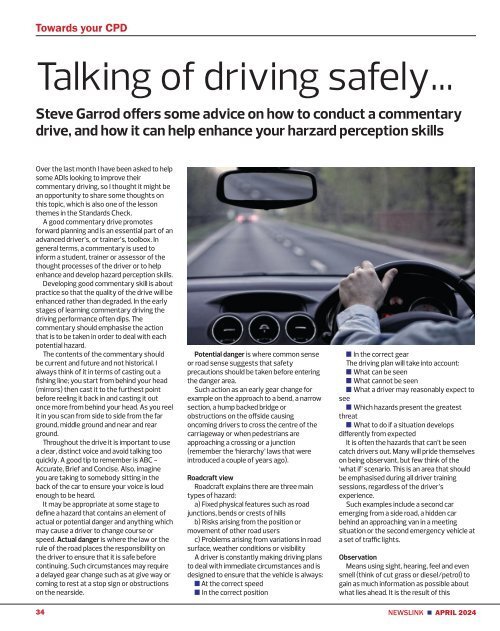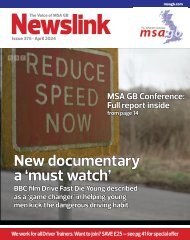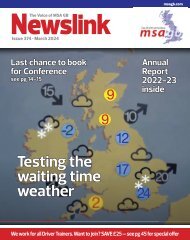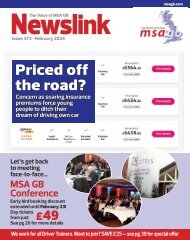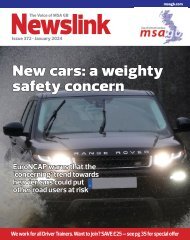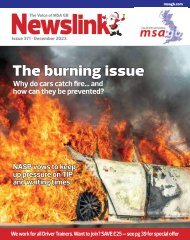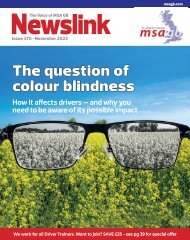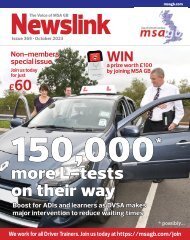Newslink April marketing special
Motor Schools Association of Great Britain - driving instructors - marketing and new members special. Road safety, driver training and testing
Motor Schools Association of Great Britain - driving instructors - marketing and new members special. Road safety, driver training and testing
You also want an ePaper? Increase the reach of your titles
YUMPU automatically turns print PDFs into web optimized ePapers that Google loves.
Towards your CPD<br />
Talking of driving safely...<br />
Steve Garrod offers some advice on how to conduct a commentary<br />
drive, and how it can help enhance your harzard perception skills<br />
Over the last month I have been asked to help<br />
some ADIs looking to improve their<br />
commentary driving, so I thought it might be<br />
an opportunity to share some thoughts on<br />
this topic, which is also one of the lesson<br />
themes in the Standards Check.<br />
A good commentary drive promotes<br />
forward planning and is an essential part of an<br />
advanced driver’s, or trainer’s, toolbox. In<br />
general terms, a commentary is used to<br />
inform a student, trainer or assessor of the<br />
thought processes of the driver or to help<br />
enhance and develop hazard perception skills.<br />
Developing good commentary skill is about<br />
practice so that the quality of the drive will be<br />
enhanced rather than degraded. In the early<br />
stages of learning commentary driving the<br />
driving performance often dips. The<br />
commentary should emphasise the action<br />
that is to be taken in order to deal with each<br />
potential hazard.<br />
The contents of the commentary should<br />
be current and future and not historical. I<br />
always think of it in terms of casting out a<br />
fishing line; you start from behind your head<br />
(mirrors) then cast it to the furthest point<br />
before reeling it back in and casting it out<br />
once more from behind your head. As you reel<br />
it in you scan from side to side from the far<br />
ground, middle ground and near and rear<br />
ground.<br />
Throughout the drive it is important to use<br />
a clear, distinct voice and avoid talking too<br />
quickly. A good tip to remember is ABC -<br />
Accurate, Brief and Concise. Also, imagine<br />
you are taking to somebody sitting in the<br />
back of the car to ensure your voice is loud<br />
enough to be heard.<br />
It may be appropriate at some stage to<br />
define a hazard that contains an element of<br />
actual or potential danger and anything which<br />
may cause a driver to change course or<br />
speed. Actual danger is where the law or the<br />
rule of the road places the responsibility on<br />
the driver to ensure that it is safe before<br />
continuing. Such circumstances may require<br />
a delayed gear change such as at give way or<br />
coming to rest at a stop sign or obstructions<br />
on the nearside.<br />
Potential danger is where common sense<br />
or road sense suggests that safety<br />
precautions should be taken before entering<br />
the danger area.<br />
Such action as an early gear change for<br />
example on the approach to a bend, a narrow<br />
section, a hump backed bridge or<br />
obstructions on the offside causing<br />
oncoming drivers to cross the centre of the<br />
carriageway or when pedestrians are<br />
approaching a crossing or a junction<br />
(remember the ‘hierarchy’ laws that were<br />
introduced a couple of years ago).<br />
Roadcraft view<br />
Roadcraft explains there are three main<br />
types of hazard:<br />
a) Fixed physical features such as road<br />
junctions, bends or crests of hills<br />
b) Risks arising from the position or<br />
movement of other road users<br />
c) Problems arising from variations in road<br />
surface, weather conditions or visibility<br />
A driver is constantly making driving plans<br />
to deal with immediate circumstances and is<br />
designed to ensure that the vehicle is always:<br />
n At the correct speed<br />
n In the correct position<br />
n In the correct gear<br />
The driving plan will take into account:<br />
n What can be seen<br />
n What cannot be seen<br />
n What a driver may reasonably expect to<br />
see<br />
n Which hazards present the greatest<br />
threat<br />
n What to do if a situation develops<br />
differently from expected<br />
It is often the hazards that can’t be seen<br />
catch drivers out. Many will pride themselves<br />
on being observant, but few think of the<br />
‘what if’ scenario. This is an area that should<br />
be emphasised during all driver training<br />
sessions, regardless of the driver’s<br />
experience.<br />
Such examples include a second car<br />
emerging from a side road, a hidden car<br />
behind an approaching van in a meeting<br />
situation or the second emergency vehicle at<br />
a set of traffic lights.<br />
Observation<br />
Means using sight, hearing, feel and even<br />
smell (think of cut grass or diesel/petrol) to<br />
gain as much information as possible about<br />
what lies ahead. It is the result of this<br />
34 NEWSLINK n APRIL 2024


